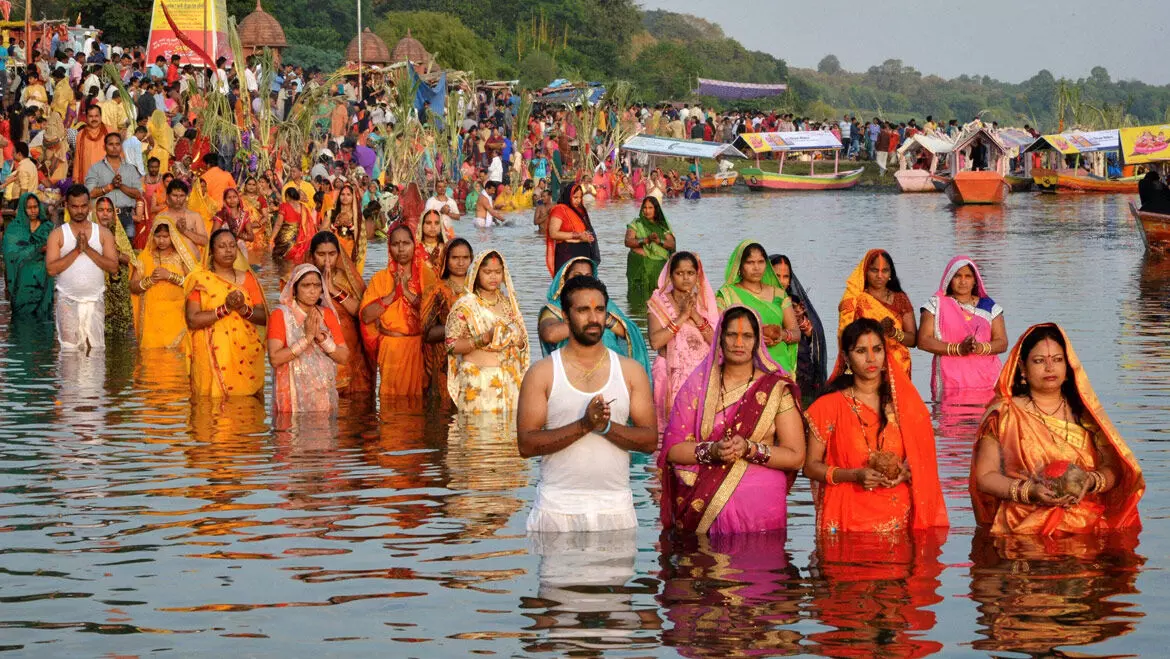TRENDING TAGS :
Chhath Puja: Celebrating Sun, Nature, and Spiritual Renewal
Discover the enchanting world of Chhath Puja – a vibrant celebration of sun worship, nature, and spiritual renewal.
Chhath Puja: Celebrating Sun, Nature, and Spiritual Renewal (pc:social media)
In the heart of India, where tradition and spirituality intertwine, Chhath Puja emerges as a radiant celebration that pays homage to the sun god, Surya, and the natural elements. This ancient Hindu festival, primarily celebrated in the states of Bihar, Jharkhand, Uttar Pradesh, and parts of Nepal, has grown in popularity and significance across the country and beyond. Let's delve into the rich tapestry of Chhath Puja, exploring its rituals, cultural significance, and the profound connection it fosters between man and nature.
The Essence of Chhath Puja:
Chhath Puja, also known as Surya Shashti, is a four-day-long festival dedicated to the worship of the sun god. Celebrated on the sixth day after Diwali, it usually falls in October or November, aligning with the Hindu calendar's month of Kartika. The festival holds immense cultural and spiritual significance, symbolizing purity, devotion, and gratitude towards the life-sustaining energy of the sun.
Rituals and Observances:
The rituals of Chhath Puja are meticulous and demanding, requiring sincere dedication from its participants. Devotees, predominantly women, observe a rigorous fast, abstaining from water and food for an extended period. The fast is broken with the offerings made to the setting sun on the first day.
The second day involves a day-long fast and the preparation of traditional offerings known as 'Thekua' and 'Rasiyaw'—sweets made from wheat flour, jaggery, and fruits. As the sun sets, devotees gather at riverbanks, ponds, or any water body to perform the 'Kharna,' where they offer water and 'prasadam' to the setting sun.
On the third day, the main day of Chhath Puja, devotees congregate before sunrise to offer 'Arghya' to the rising sun. The 'Arghya' involves standing waist-deep in water and presenting a basket of offerings, including fruits, sugarcane, and earthen lamps, to the sun god. This ritual is a mesmerizing spectacle, symbolizing the connection between man, nature, and the divine.
The final day, also known as 'Paran,' marks the conclusion of the fast. Devotees, after performing the morning rituals, break their fast, often with a community feast. The atmosphere is filled with joy, gratitude, and a sense of spiritual renewal.
Cultural Significance:
Chhath Puja transcends religious boundaries, embodying a cultural heritage that unites communities. The festival fosters a deep respect for the environment and the elements, emphasizing the interdependence between humans and nature. The rituals, steeped in tradition, reflect the agrarian roots of the region, expressing gratitude for a bountiful harvest and seeking blessings for future prosperity.
Harmony with Nature:
Chhath Puja is not just a religious observance; it is a celebration of the symbiotic relationship between humanity and the natural world. By standing in the water, facing the rising or setting sun, devotees acknowledge the life-enabling force of the sun and express their gratitude for its warmth and energy. The act of fasting and offering prayers amidst nature creates a profound connection, fostering a sense of environmental consciousness and responsibility.
Chhath Puja, with its blend of devotion, discipline, and environmental consciousness, stands as a testament to India's rich cultural heritage. Beyond its religious connotations, the festival offers a universal message of gratitude, harmony with nature, and the enduring connection between the human spirit and the celestial bodies that govern our existence. As the sun sets on the final day of Chhath Puja, it leaves behind a renewed sense of spirituality and a deep appreciation for the interconnectedness of all living things in the vast tapestry of existence.



